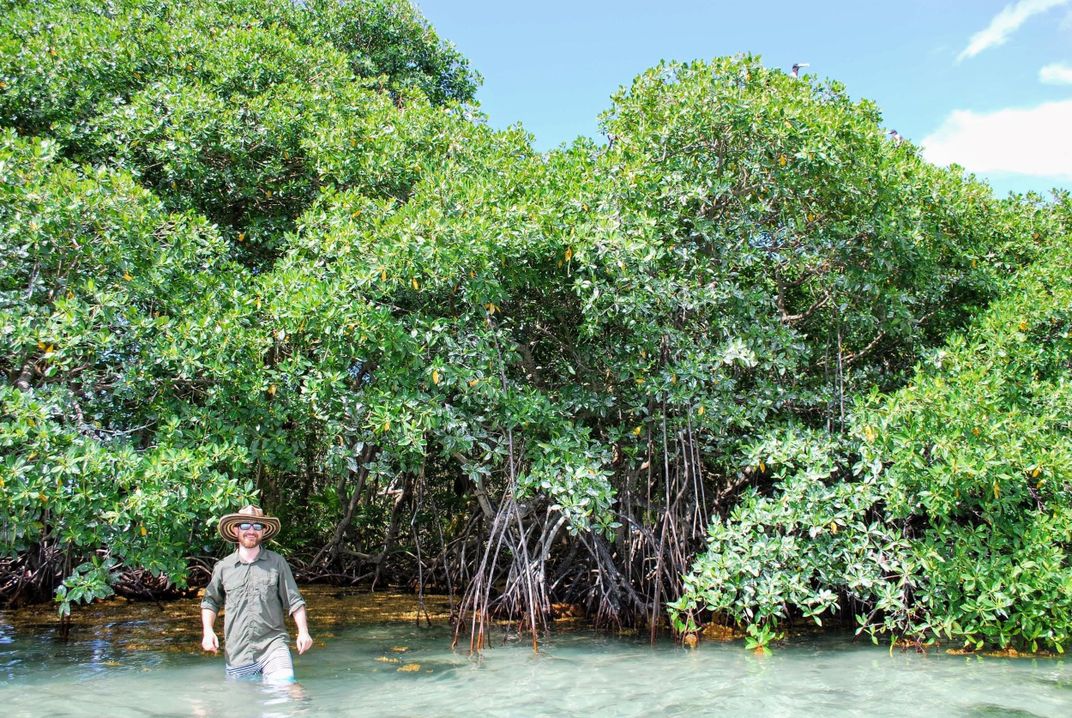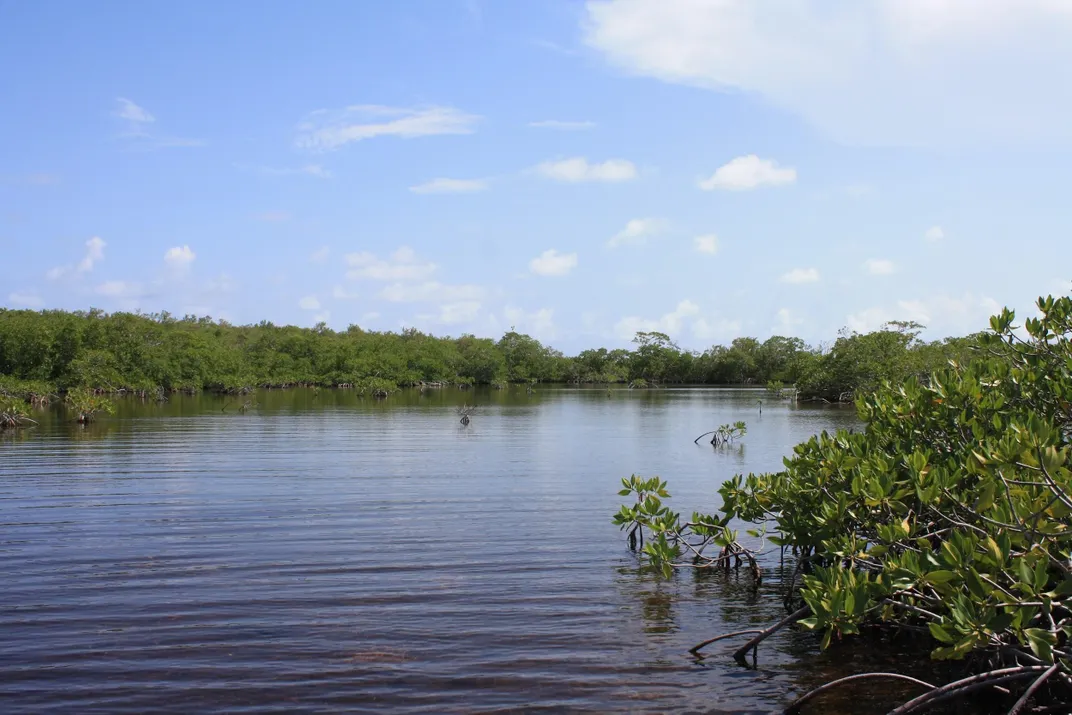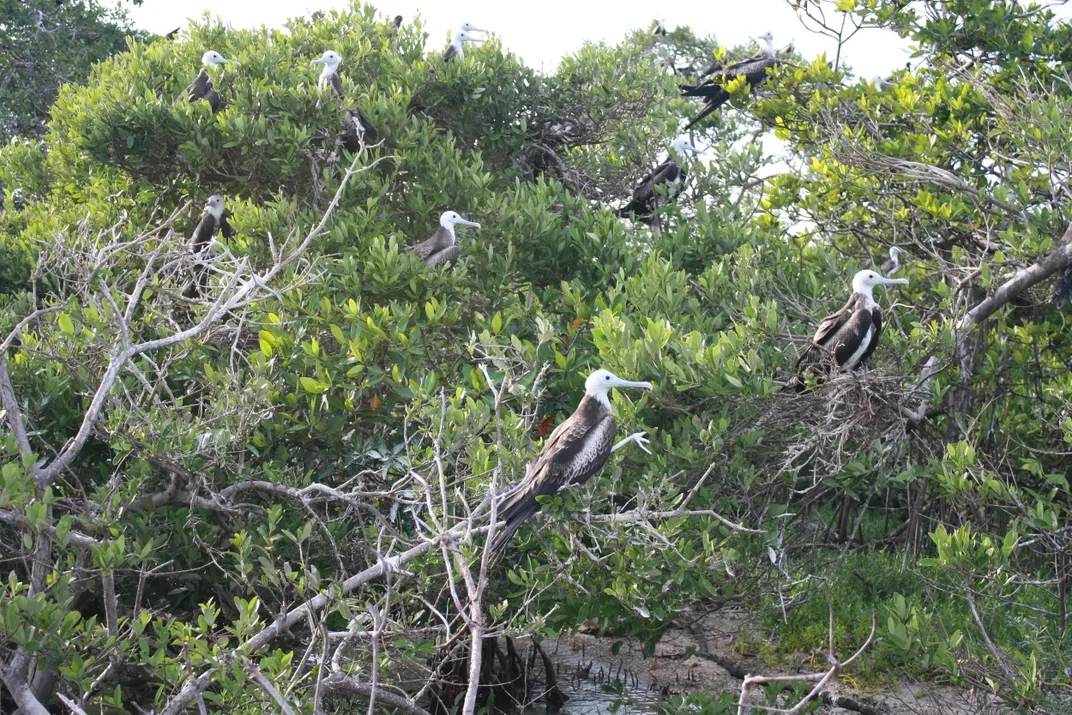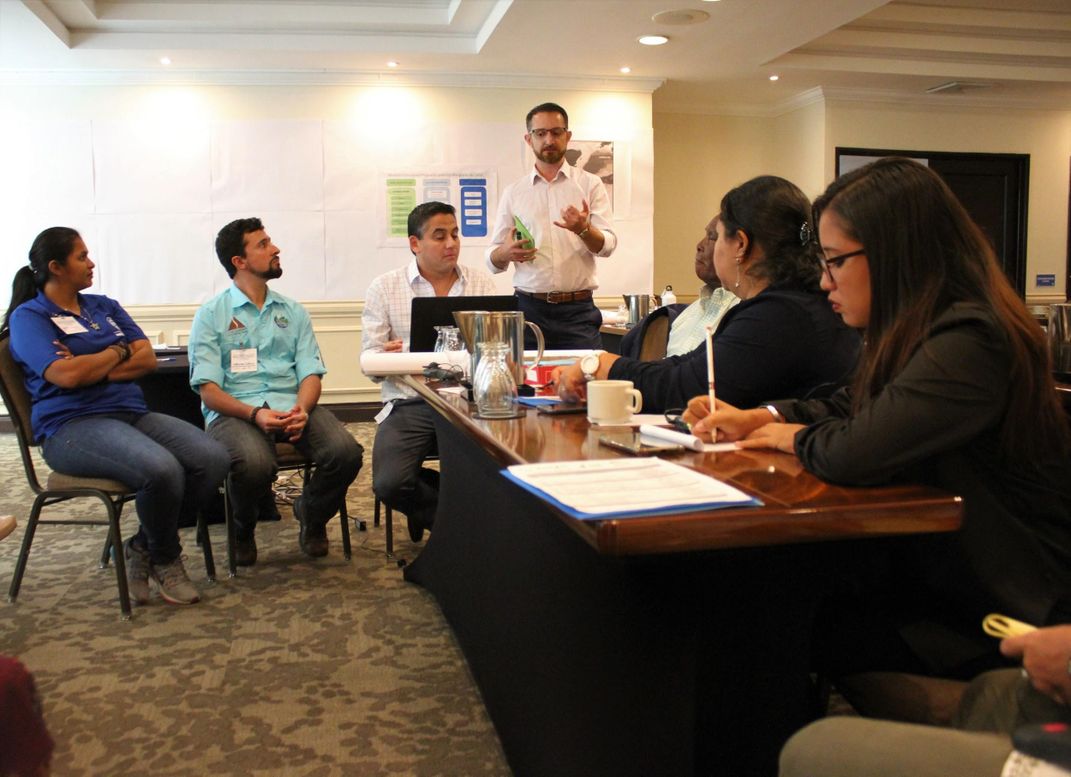NATIONAL MUSEUM OF NATURAL HISTORY
Together, We Can Save the Mangroves
Scientists hope to save mangroves with global collaboration.
/https://tf-cmsv2-smithsonianmag-media.s3.amazonaws.com/blogging/featured/A_river_lined_with_trees_on_both_sides..jpg)
A boa dozes lazily in the boughs of a mangrove tree in Belize, while birds nest nearby and white mangrove orchids adorn the tree’s woody branches. Oysters, sea anemones and algae cling to its tangled roots, which dip beneath the water and give shelter to fish. Hundreds of plants and animals rely on trees like this one throughout their life.
Mangrove ecosystems are one of the most valuable in the world, not only for the habitat they provide for wildlife, but also because they prevent coastal erosion and absorb and store carbon dioxide from the atmosphere. Climate change and deforestation have driven mangroves into decline, though deforestation has slowed in the last decade.
Steve Canty, the coordinator of the Smithsonian Institution’s Marine Conservation Program and part of the Smithsonian’s Working Land and Seascapes, hopes to help create management strategies to further slow the loss of mangroves.

Mangroves and fisheries are connected
Canty studies mangroves and fisheries in the Mesoamerican reef (MAR) region, which stretches through Honduras, Guatemala, Belize and Mexico. Fisheries are important contributors to the GDP of this area.
“They provide food security and livelihoods and are often the economic backbone of coastal communities,” Canty said. To effectively manage fisheries, Canty also needs to look at their habitat: mangroves.
Mangroves are important feeding grounds and nurseries for fish, meaning some fish species spend their juvenile years sheltering between mangrove roots before living on coral reefs or in the open ocean as adults. When mangrove forests decline, it can cause devastating effects on fish populations. One square mile of mangroves lost can cause 275,000 pounds of lost fish per year.
Fisheries in the MAR region are under pressure for several reasons, including a high demand for fish from the United States and habitat loss. Canty helps identify the best areas for fish recuperation zones, or no-take zones, to help fish populations grow.
He has 40 different research sites in Mesoamerica, from which he has collected samples of mangroves. He uses genetic analyses to determine how the mangroves at one site are related to mangroves at a different site. This tells him how connected the populations are, and whether they should be managed separately or as one unit.
Canty compares these data to how fish populations are related to one another across these sites and sees if he can detect patterns of connectivity. By taking into account both the mangroves and fish together, he can advise on how to create a connected network of marine reserves, rather than protecting isolated pockets.

Mangroves are part of a tropical system
Seagrasses and coral reefs are also important habitats for fish and other species. They all are highly connected and depend on each other for health. But in the past, scientists have not always looked at these holistically.
“Where mangroves, coral reefs and seagrasses are connected and healthy, they can significantly increase the productivity of fisheries,” Canty said. “So, it's important that you don't disregard one. You have to treat it as a tropical system, rather than focusing on each individual piece.”
Now when thinking about a management strategy for the MAR, and determining the best spots for protected areas, Canty looks at all these pieces together, and includes scientists who are studying each aspect of the region’s ecosystem.

Saving the mangroves
During his research, Canty found that the MAR region lost over 270,000 acres of mangroves between 1990 and 2010. That’s 31% of its mangroves in 20 years.
Canty credited this partially to a lack of a unified strategy between the four countries, and a disconnect between science and management. Scientists were concerned about climate change and other long-term environmental factors, while the people managing mangroves saw day-to-day development and agriculture as the biggest threat.
To bridge the gap, Canty started the Mesoamerican Mangrove and Seagrass network, an online platform for scientists, mangrove managers and community members to exchange ideas about how to conserve mangroves and seagrasses back in 2018.
Members of local communities are the most important piece, Canty said, because ultimately, they decide whether they want to protect or restore areas and can ask the network for help for their communities. The network allows for easier communication between these key players, and others, across all four MAR countries.
“Now if people have a question about mangroves, they have access to 30-35 scientists — most of whom are from the region — who are willing to provide them with the best advice they can,” Canty said. “And the network gives scientists studying different areas and species within the MAR a chance to share research and collaborate with each other.”
With MAR Fund, an organization that allocates funding to conserving the Mesoamerican Reef, and the Embassy of Germany in Guatemala, Canty helped organize a workshop last September to bring people together from the region to discuss mangroves.

From that meeting, MAR Fund and Canty collected the ideas that attendees shared and produced a 64-page management strategy.
“It’s not just an issue of policy or management, it’s involving everything: research, management, protection, policy and fundraising,” María José Gonzalez, the executive director of MAR Fund, said. “You need to come together with all these elements and all these stakeholders to actually ensure that you will be able to protect and restore mangroves.”
Gonzalez and Canty hope this strategy will serve as a model for mangrove management across the globe.
“We have people talking to us about mangroves from further down in Central America and also South America, Africa and the wider Caribbean in general,” Canty said. “There's a big push right now for mangrove restoration.”
The Global Mangrove Alliance, which the Smithsonian Institution is a part of, has a goal of increasing the world’s mangrove cover by 20% by 2030. Canty thinks the management strategy for the MAR region can be shared and replicated across the world to help reach this goal.
After sharing the strategy with partners across the world, Gonzalez said the next step is to create updated maps for mangroves in the MAR region. The maps can be used in conservation and research, and hopefully aid in creating protected areas. Though mangrove forests have been decreasing, management plans and international collaboration have helped slow the decline across the world, and Canty hopes that the MAR region will be no different.
“Mangrove ecosystems are important to the MAR in so many different ways,” Canty said. “When we work together, share resources and common goals, we can make a real impact.”
Related stories:
Can Genetics Improve Fisheries Management?
This Earth Day, the Planet’s Health is Your Health
Discovery and Danger: The Shocking Fishes of the Amazon's Final Frontier

